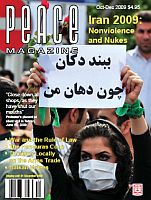
Peace Magazine Oct-Dec 2009, page 30. Some rights reserved.
Search for other articles by Shirley Farlinger here
by Ellen Leopold, Rutgers University Press, New Brunswick, New Jersey and London, 2009. US$25.95.
Cancer and the Cold War seem unrelated. But Ellen Leopold's Cancer and the Cold War shows clearly how the nuclear testing following Hiroshima and the production and testing of new nuclear weapons influenced the lack of meaningful examination of increasing cancer rates in the US.
Nuclear testing could not have continued if the fallout was causing cancer and people put the two together. The Nevada Test Site "downwinder" victims, the Japanese fishing boat deaths, and the cancer in uranium miners all contributed to a wake-up call the government didn't want to hear, Leopold notes. She claims 250,000 US soldiers were exposed to radiation with no safety instructions, no monitoring badges, and often no protective gear. The money for nuclear testing far outweighed any funding for examining the effects. The trick was to look for a radiation level that would not be harmful to humans. As we now know, radiation at any level is damaging.
But what if this new technology could be put to use to treat cancer? The book details the torture of one woman treated with Cobalt-60. Although this is no longer used, other radiation treatments for cancer patients are now routine.
As the fears of the Cold War subsided the cancer studies became more open and competent. Instead of small, diverse, uninformed subjects the trials now included the educated middle class who might be so bold as to sue the government. Legislating informed consent was a help but no guarantee. An article quoted from The Washington Post in 1981 noted 620 deaths attributable to experimental cancer treatments.
Cancer policy in the US, Leopold maintains, is driven by the profit motive so prevalent in the US health system. There is no profit in prevention so prevention is not undertaken. US doctors are placed in a difficult position, Leopold admits, as desperate patients consult them on further treatment.
Studies of the connections between lifestyles and cancer are inconclusive. According to Leopold there is no proven connection between obesity, stress, or diet and cancer. Of course the medical establishment, especially government bodies, chooses to lay the blame for cancer on individuals.
The 1963 Limited Test Ban Treaty sent the experiments underground and lessened the radiation proliferation but did not end it. The wave of new chemicals, part also of the Cold War, led to the struggle of residents of Love Canal for redress. The book has many examples of legal avenues tried, such as the amendment to the Food, Drug and Cosmetics Act of 1958 which outlawed carcinogens in all products. It passed but was later retracted due to business pressure on the government.
In Canada we need our own publicly funded research into the health effects of radiation from all sources. This book describes many such attempts and gives us many reasons why more cancer research is necessary.
I have a personal interest as my struggle with cancer reaches seven years of operations, mammograms, CT scans (the equivalent of 500 X-rays) and chemotherapy. Does living 70 years in Toronto, the middle downwind ground between the Bruce plants and the Pickering and Darlington plants, have anything to do with my cancer? I don't know and until proper studies are done I will never know.
Reviewed by Shirley Farlinger.

Peace Magazine Oct-Dec 2009, page 30. Some rights reserved.
Search for other articles by Shirley Farlinger here